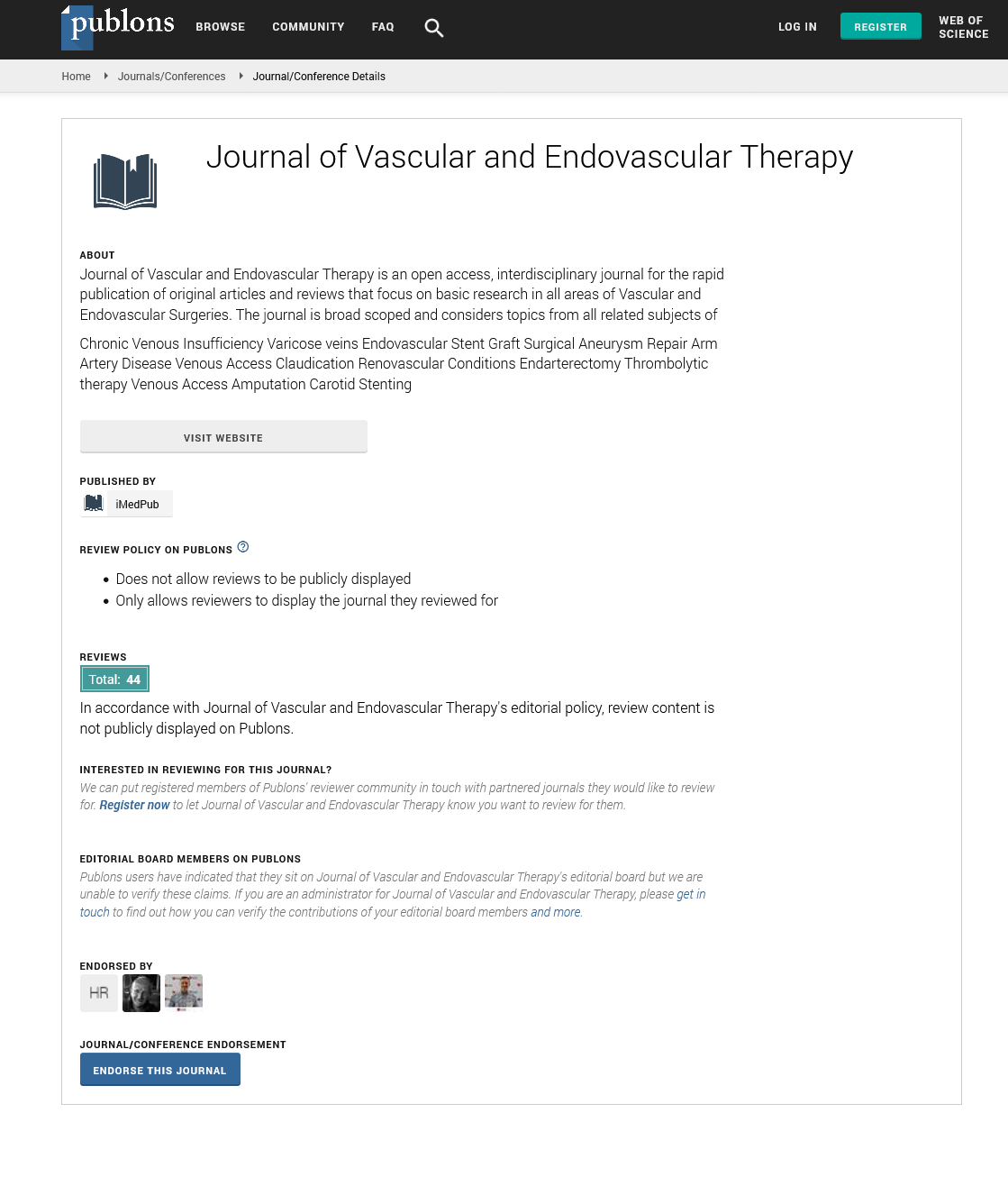ISSN : 2634-7156
Journal of Vascular and Endovascular Therapy
Endoleak: Complication Incidences and Treatment Outcomes of Endovascular Aneurysm Repair-A Single-Center 10 Year Follow-Up Study
7th Edition of World Congress & Exhibition on VASCULAR SURGERY
November 29-30, 2021 Webinar
*M S Khalid, Ravi Goel, Lewis Palmer, Aish Avula, H Elsantawy, A Almetwally, , A A
Halim, H Al-Khaffaf
Royal Blackburn Hospital-East Lancashire, UK
ScientificTracks Abstracts: J Vasc Endovasc Surg
Abstract
Introduction: Endoleak is a common complication of endovascular aneurysm repair (EVAR) which occurs in 25% of patients. There are 5 types of endoleaks, with type 2 being the most common. Aims: Our aim is to review all EVARs performed at ELHT between 2011- 2020, to identify endoleaks as a complication, how they were managed, and what was the outcome? Material & Method: Patients were identified by searching for the EVARs that had taken place at ELHT between 24/10/2011. 27/09/2020. A retrospective review of the case notes, radiology, and discharge summaries was carried out. Results: 272 patients had an EVAR between 2011-2020 (3 of which were revisions). 229 (84.2%) patients of these had no endoleak following EVAR. 40 patients (14.7%) had a confirmed endoleak. Among these 37 were male and 3 were female. Mean age was 76 years (range 60-88 years). 21 (52.5%) of patients who had an endoleak are now deceased - no documentation to suggest that the deaths were related to a ruptured aneurysm or endoleak. Out of the 19 patients, 9(47%) patients had Endoleak type2. Out of these 9 patients 2 were treated with Onyx embolization, 1 was offered balloon molding while 6 patients resolved under surveillance without any treatment. Endoleak Type 1 was seen in 6 (31.5%) patients, two out of these 6 were offered balloon molding and onyx embolization respectively, while 4 resolved without any treatment. In our study, 2 (10.5 %) patients had type 3 Endoleak who were treated with stent extension and balloon molding. 1 (5.2%) patient had endoleak with no type labelled but had redo EVAR. Conclusion: The most common endoleaks worldwide following EVAR are type 2 endoleaks. In the last 10 years at ELHT, type 2 endoleaks were the most common in line with national data. We can see the incidence of type III endoleaks at ELHT is comparable to large randomized controlled trials at 5%.Most resolved with no intervention or are under surveillance with no change in sac size. In summary, we have had no deaths related to rupture following endoleak to the best of our knowledge. Our complication rates compare favorably with the results achieved in many tertiary centers for EVAR procedure.' Key words: EVAR; arterial aneurysms; complications; endovascular procedures
Biography
Muhammad Sufian Khalid is currently working in the Department of Vascular Surgery at Royal Blackburn Hospital-East Lancashire, UK. His research interest mainly focusses on Vascular Surgery.
Google Scholar citation report
Citations : 177
Journal of Vascular and Endovascular Therapy received 177 citations as per Google Scholar report
Journal of Vascular and Endovascular Therapy peer review process verified at publons
Abstracted/Indexed in
- Google Scholar
- Open J Gate
- Publons
- Geneva Foundation for Medical Education and Research
- Secret Search Engine Labs
Open Access Journals
- Aquaculture & Veterinary Science
- Chemistry & Chemical Sciences
- Clinical Sciences
- Engineering
- General Science
- Genetics & Molecular Biology
- Health Care & Nursing
- Immunology & Microbiology
- Materials Science
- Mathematics & Physics
- Medical Sciences
- Neurology & Psychiatry
- Oncology & Cancer Science
- Pharmaceutical Sciences
